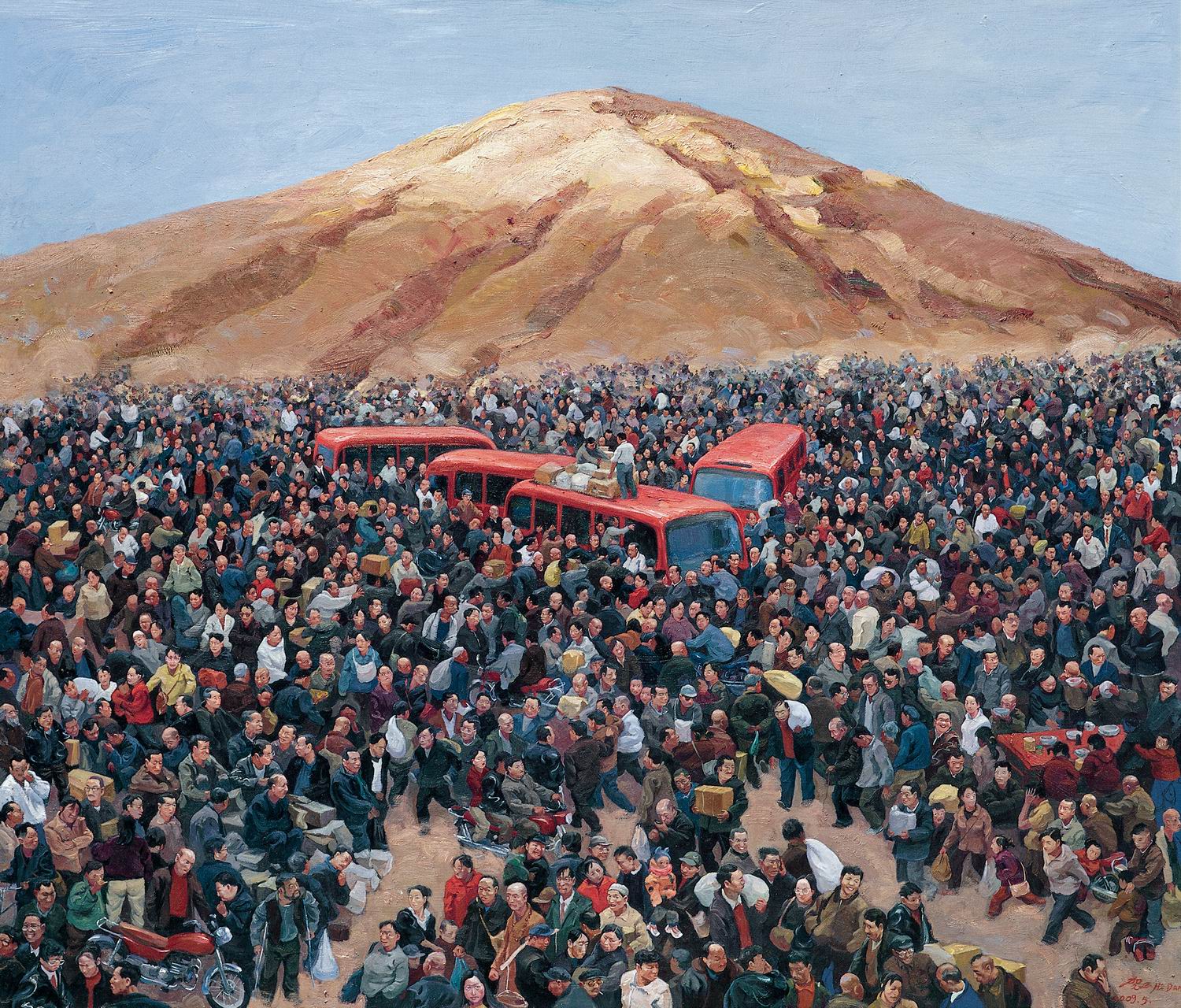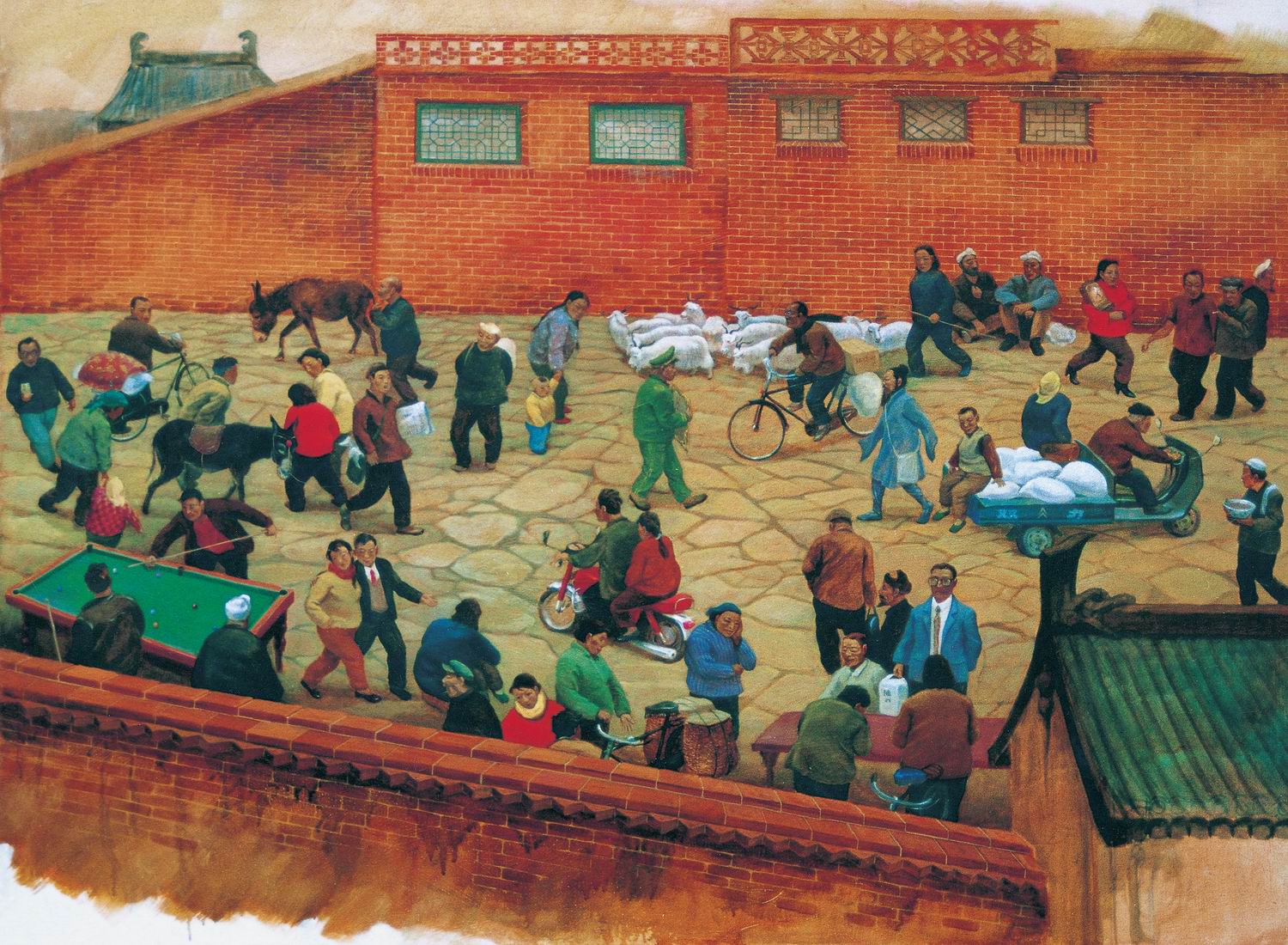评论观点
Comment
贺丹的人群
发布时间:2019-08-13

文:彭德
贺丹的油画素材,画的是人群,是人群体现的社会习性。从早期的风俗画到后来的寓意画,这一素材持续不变;即便改画蚁群和蜂群,也是人群的变体。描绘人群的风俗画满足的是看画者的猎奇心理,描绘人群的寓意画表达的是作者对人群的观察和思考。贺丹画人群,从陕北故乡的民众画到西安的民众再到中国各地的民众,以陕西民众最为典型。陕西作为周秦汉唐的根据地,承载着绵延数千年的农业文明。民众既是农业文明的主体,也是农业文明的客体。褒义而论,一唿百应是聚众的起始,万众一心是聚众的效果,和而不同是聚众的理想。几千年来,圣人和帝王们始终在调动这种意识,矢志不渝。人群蕴含的力量是一种暗能量,形同双刃剑具有正负两面。20世纪以来,绘画作品体现的总是人群的正能量,忽视了它携带的负能量。贺丹的艺术,让人更多的窥见出事情的另一面。
人群聚集的背后通常是一窝蜂的从众心理。周秦两汉帝王出城祭祀、誓师、田猎、大傩以及后起的行城、法会等等,都是聚众的理由。古代最刺激的聚众缘于罪犯游街和枭首示众,它们是调动从众者亢奋情绪的节日。从众而围观的民众并不在意被揪斗者、枭首者犯了什么罪行,更不在意是否犯罪和为什么犯罪,而只是激动于揪斗和枭首本身,激动于“非我族类,其心必异”的排他情怀。1966年,延安的街头,刚上小学的贺丹跟着一群打着红旗吆喝着口号的人看热闹,围观被揪斗游街的走资本主义当权派。贺丹挤进密集而骚动的人群中央,发现被揪斗的人物竟然有自己的母亲。母亲被游街,在他幼小的心灵中留下了巨大的阴影和永不磨灭的伤痛。当他回顾为什么总是在画人群时,这个经历成了他拿起画笔就很难摆脱的起因。
人群聚集的背后还体现出血缘或心性上的裙带关系。这种裙带关系的形成,或因为亲属而捆绑,或出自投机而附会,或由于精神空洞而凑合。裙带之间不论是含有利益取向的聚集,比如传销组团、邪教法会、黑社会滋事,还是无利或损利的扎堆,比如无所事事的围观,都属于乌合之众,而乌合之众是以自我的缺失充当粘合剂的。有人在广场中央朝着空无一物的天空故意凝视,随即会有人跟着凝视,然后是众人聚集而凝视,进而聚集者会越来越多,哪怕带头者早已熘之大吉。贺丹的作品描绘了不少这样的场景与人群。比如他把茫然无事的人群画成海洋,把成群结队的宇航员煞有介事地处置在草地上行走寻觅,使荒诞的场景切合人群集结的荒诞逻辑。
人群聚集的背后总会显示出等级观念。物以类聚、人以群分,成为等级划分持久有效的理论依据。贺丹笔下的人群,几乎是清一色的底层人士,包括市民、村民、游民。这类在精英心目中的芸芸众生,无法支配中国的走向,却是决定国民总体品位的巨大力量。
人群聚集背后的集体无意识,其本性在于信仰、习俗和生存方式的趋同。几千年酝酿而成的帝国思想,通过传世的法典与制度加以承袭,使得众生类似群居动物一样,在无意识状态下受本能驱使而加以盲目的服从,进而使得农业文化始终维持稳定不变的态势。这种稳定不变的态势反过来沉淀为民众行为趋同的集体表象。集体表象和集体无意识没有发起者,没有专利者,没有责任人,大家都是不由自主被裹挟的当事人和目击者。它需要无数个体的参与,却不需要个体对参与的质疑。其结果,人群不断在变,生生不息,无论过去的人群还是现在的人群体现的集体表象和集体无意识却始终不变。尽管布留尔在上世纪对此作过深入研究,其基本思想早已广播中国文化界思想界,可是国人的习气却没有明显改观。
贺丹有很强的油画写实功夫。他的创作很少画素描草图,通常是按照画中的情境逻辑随意勾画人物和背景,一次成形。随意勾画的方式同人群的随意聚集,在形式上同构。贺丹不像社会学家揭示问题,而是描绘现象。这种描绘比揭示问题具有更多的反思空间。作者的想法隐退在画面背后,作品没有沉重的思绪和激愤的外表,只有中性的呈现。这种呈现展示出内在而无声的意蕴,给评议者提供了自由切入的角度,引出各种想法,也能引出各种历史图景。比如秦始皇陵陪葬坑中的兵马俑、汉景帝阳陵殉葬坑中的妃嫔群、唐墓壁画中的人群图,还能联想到种种中国典故和成语,诸如殉葬仪轨、连坐制度、众口铄金之类。他的画也可以联想到各地的民俗,比如京城公园聚集的神侃者,西安路边的闲谝圈子,武汉街头人事摩擦而随聚随散的劝架团,成都茶馆摆龙门阵的好事者。此外,春节返乡潮、元宵花灯会、清明上坟节、端午竞渡时、重阳登高处等一年一度的聚众场面以及偶然形成的热点,包括房闹、医闹、婚闹等等,都能调动兴趣点很低、素质不高的闲人们的聚集激情。人口总数比美、俄、巴、日、德、英、法、加、澳、墨加起来还多的中国人,这种国民习性会长期延续,因而贺丹的艺术将会始终与我们同在。

He Dan's crowd
Written by Peng De
He Dan's oil painting subject is the usual crowd, and he pays special attention to the social habits embodied by the crowd. From the early genre paintings to the later more implied paintings, this topic has been used continuously. Even if you exchange the ant colony and the bee colony, it is a variant of the crowd image. The genre painting depicting the crowd satisfies the curiosity of the audience. The manifold portrayals of the crowd theme express the author's commitment with it resulting in continuous observation and reflection of the crowd as a content. The people painted by He Dan reach out from the people in his hometown of northern Shaanxi to people of Xi'an and to people of all parts of China. Among them, the Shaanxi people he painted are the most distinctive ones. As the base of the Zhou, Qin, Han and Tang Dynasties, Shaanxi carries the heritage of an agricultural civilization that has lasted for thousands of years. The people are both, the main body of this agricultural civilization and the object of agricultural civilization. Rightout we can distinguish, the interest in gathering people at the beginning , and later on the occupation with the effects of gathering people, producing something like an ideal form of depicting gathering people. For thousands of years, saints and emperors have always tried to shape and influence common consciousness by different means, and have never stopped to do so in various attempts. The power contained in a crowd is a huge potential energy, and we could look at it as a double-edged sword with two sides, one representing positive energy the other one negative energy. Since the 20th century, paintings have always reflected on the positive energy of the crowd, ignoring the other possibilities it carries as a potentiality, especially the one of negative energy. The art of He Dan gives people more insight into the other side of the world.
Behind each crowd gathering there is usually a sort of crowd psychology at work an unconscious approach similar to acting in a unclear and confused manners. The emperors of the Zhou Dynasty, the Qin Dynasty and the Han Dynasty went out to the city to offer sacrifices to gods or ancestors: oath taking rally, hunting, Nuo opera, and later the rise of the city guard ceremony, the liberation rite of water and land, etc., all were reasons for gathering people. The most exciting gatherings in ancient times were established due to the fact that criminals were besieged by people in the streets and then beheaded in front of the crowd. These were festivals mobilizing the onlookers' excitement. The people from the crowd who watched did not care about whether any crimes were committed at all by the defenders and the beheaders. They did not care about whether somebody was guilty or not nor about why they might have sinned. They only were excited about the street fighting and the harsh punishment through beheading. They were excited about sentences like "Those who are not our kin are sure to be of a different kind“. In 1966, on the streets of Yan'an, He Dan had just entered elementary school and followed a group of people who displayed slogans with red flags and how they watched with excitement how the capitalist oppressors were forced to parade on the street. He Dan squeezed into the center of a crowd full of turbulent people, and he had to see that the person being beaten actually was his own mother. The mother was forced to parade through the streets. This particular scene had left a huge and dark imprint as well as an indelible pain in the mind of young He Dan. When reflecting why he was always intensively drawing crowds, he recognized that this experience was at the root of it , a cause that could never get rid of.
A driving force behind such crowds, might consist of an unlucky relation between mental suffering and emotional nepotism. The formation of such a nepotistic crowd is either motivated by sheer kinship, combined with the purpose of speculation, or by becoming a rabble due to spiritual emptiness. Regardless of whether there is a relationship of interest orientation between the involved formations, such as pyramid schemes, cult organizations, underworlds, or groups uniting without specific reasons,or just a few ones such as doing nothing: all belong to the rabble, and the rabble is gathered by lack of self. Just like someone staring deliberately at the empty sky in the middle of a square, and then someone else would join this person staring at the sky together , and then gradually more and more people adding up staring together even if the initiators had already slipped away. He Dan's work depicts many such scenes and crowds. For example, he painted a crowd of people with no particular aim, by letting astronauts walk in groups searching on grass in an unpredictable way. This absurd scene provides an exemplary take on the absurd logic of the rabble.
Underlying the crowd gathering there are is always the concept of hierarchy present. One could use the proverb "birds of a feather flock together“to describe it. Things are clustered and people are grouped according to traditional and effective principles. The people under He Dan's brush are almost all members of the bottom, of society including ordinary urban citizens, villagers, and migrant workers. In the elite's mind this kind of people can't determine China's development policies, but are never the less a huge force determining the quality of Chinese people’s lifestyle.
The collective unconscious behind the crowding up is based on the convergence of beliefs, customs and ways of life. The empire's ruling thoughts, which have been developing for thousands of years, have been inherited through laws and systems passed on to organize people's lives uniformed like animals in the same group. They are blindly obeying these rules as if by by instinct in an unconscious state, and thus the agricultural civilization is maintained. In such ways the state remaining stable on ultra-long-lasting terms. This stable situation has gradually manifested as a collective appearance of the people's ideological behaviors. This type of collective appearance according to a collective unconscious has no initiators, no patents, no responsible persons behind it, and everyone is part of it and one can witness how everyone is involuntarily involved. It requires the participation of countless individuals, but does not require individuals to question the legitimacy of participation. As a result, the population though constantly changing according to the laws of birth and death is living seemingly endless. In its collective appearance and collective unconsciousness though reflected by the past the present population remains unchanged. Although Lucien Lévy-Bruhl made in-depth research on this in the last century, and his basic ideas have already been broadcasted in the Chinese cultural and ideological circles, this knowledge had no impact on the habits of the Chinese people which remained without significant change.
He Dan has been trained in oil painting based on strong realism. His artistic creation usually in accordance with the contextual logic in the works, to draw characters and backgrounds at a time rarely relays on sketches,. The way of using the method of freely sketching is the same as that of the crowd massing up, and the structure is the same. He Dan does not reveal problems like sociologists, but describes phenomena. This kind of depiction has more room for reflection than just revealing the problem. The author's thoughts retreat behind the picture, the work has no heavy definition and an angry appearance, only reveals itself in a neutral presentation. This presentation demonstrates the intrinsic and silent meaning, providing the observer with a free-cut perspective, leading to ideas and a variety of historical perspectives. For example, the terracotta warriors and horses in the burial pits of the Qin Shihuang Mausoleum, the sects in the burial pits of the Hanjing Emperor, and the crowd maps in the murals of the Tang Tombs can also be associated with various typical Chinese allusions and idioms, such as funeral rituals, collective punishment, and gossip. His paintings can also be associated with folk customs in various places, such as gossipers in the Beijing’s public park, a leisure circle on the roadside in Xi'an, mediators gathering by random on the streets of Wuhan, nosey people who are making leisurely conversation in the teahouse in Chengdu. In addition, a homebound wave of people with low interest points and vulgar crowd. can be mobilized during the Spring Festival, the Lantern Festival, Tomb-Sweeping Day, the Dragon Boat Festival, the Double Ninth Festival and other annual gathering scenes and hot spots by chance. This can include as well cases of Housing Disputes, medical dispute lawsuits, wedding interrupting, etc., The Chinese people who have a larger population than the United States, Russia, Pakistan, Japan, Germany, Britain, France, Canada, Australia and Mexico will continue to live for a long time, so the art of Hedan will always be with them.
上一篇:贺丹绘画艺术的一次偶然邂逅